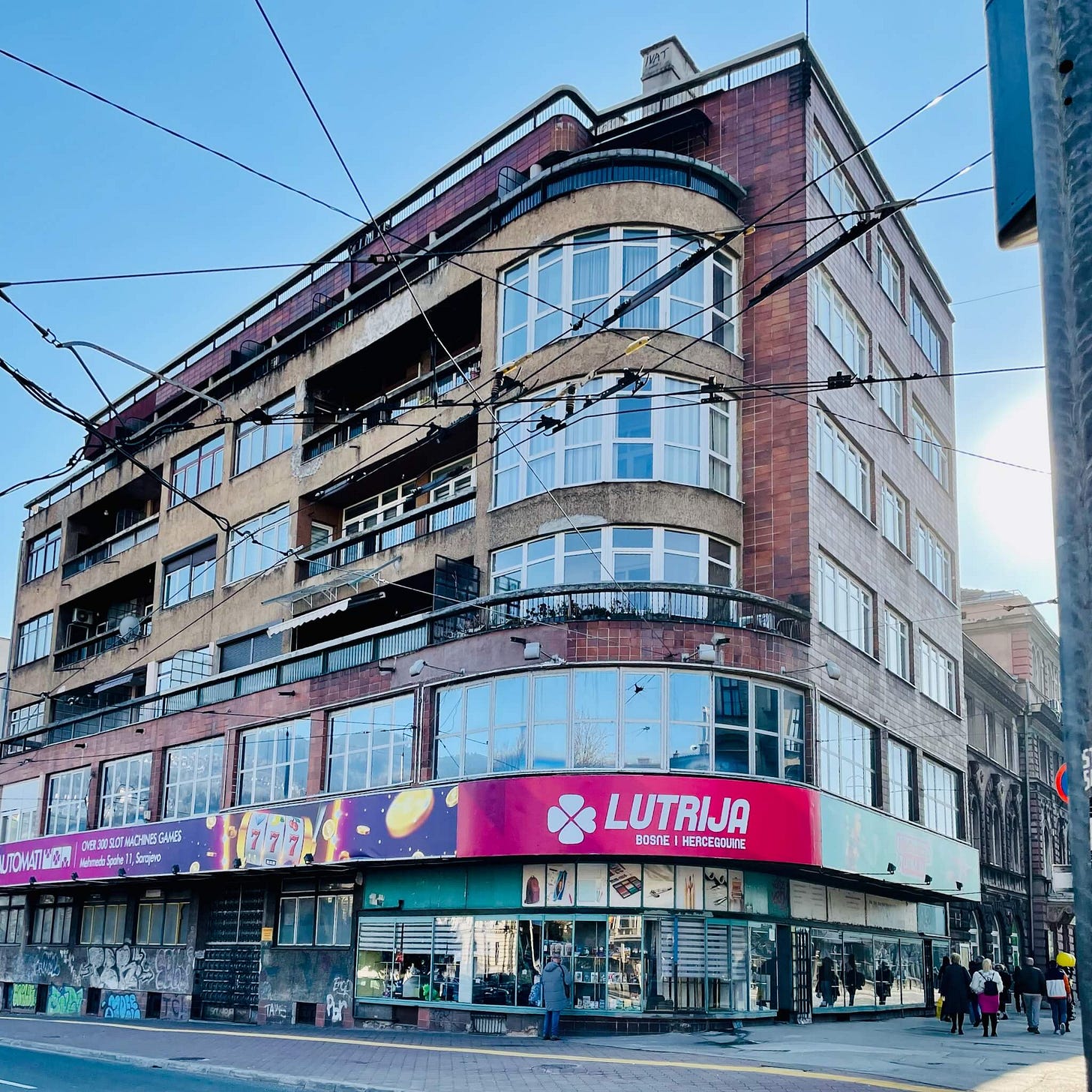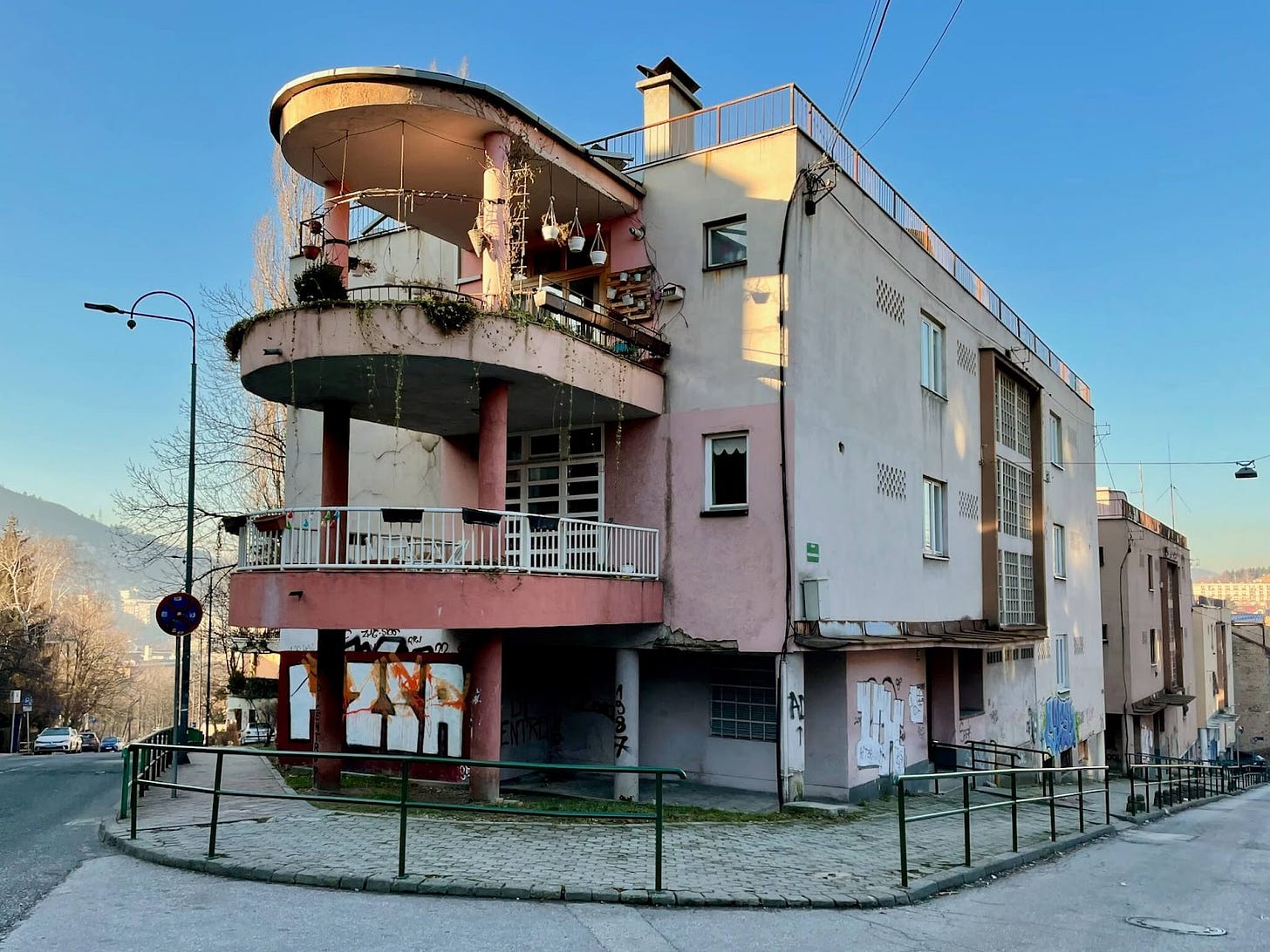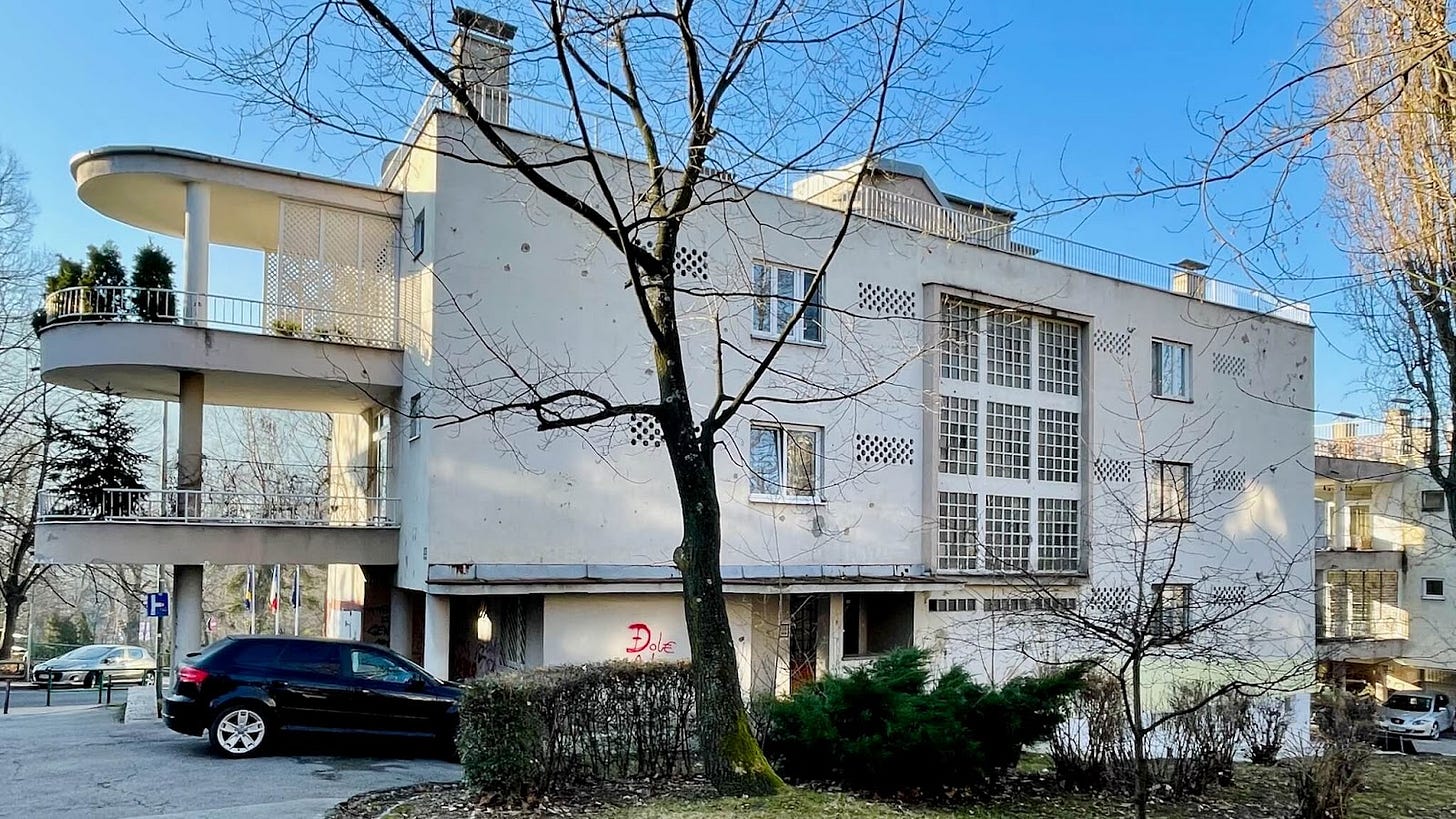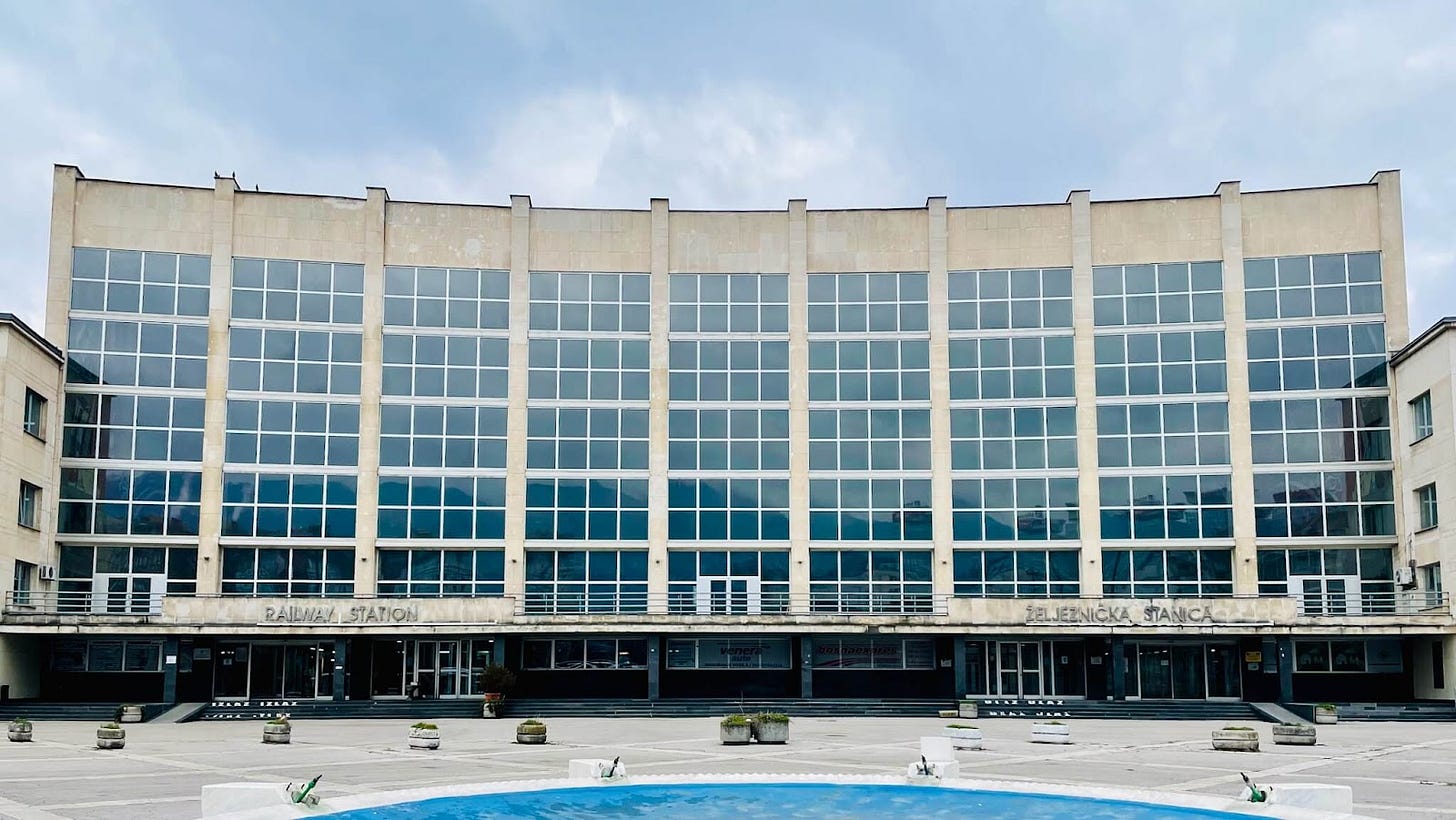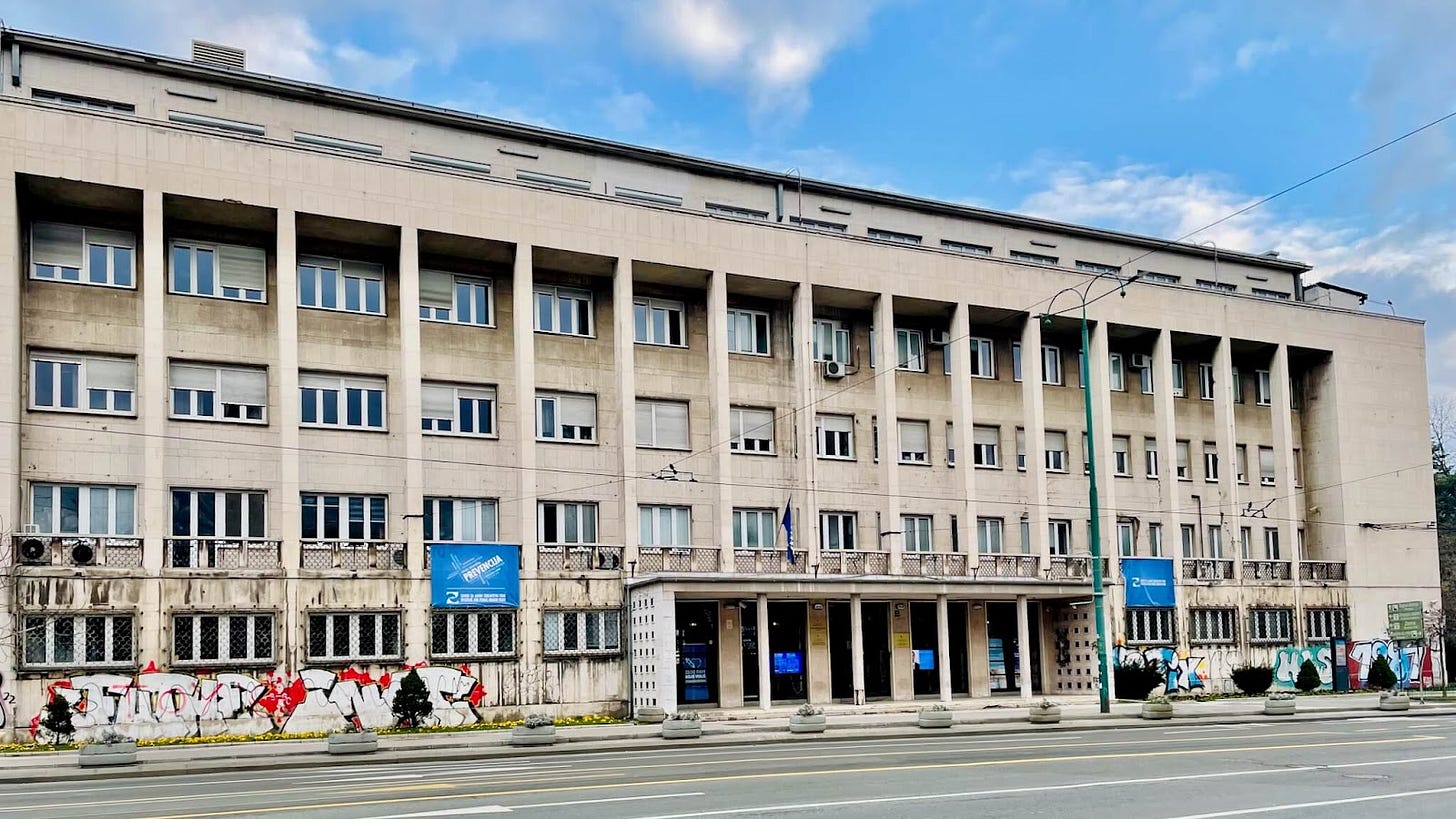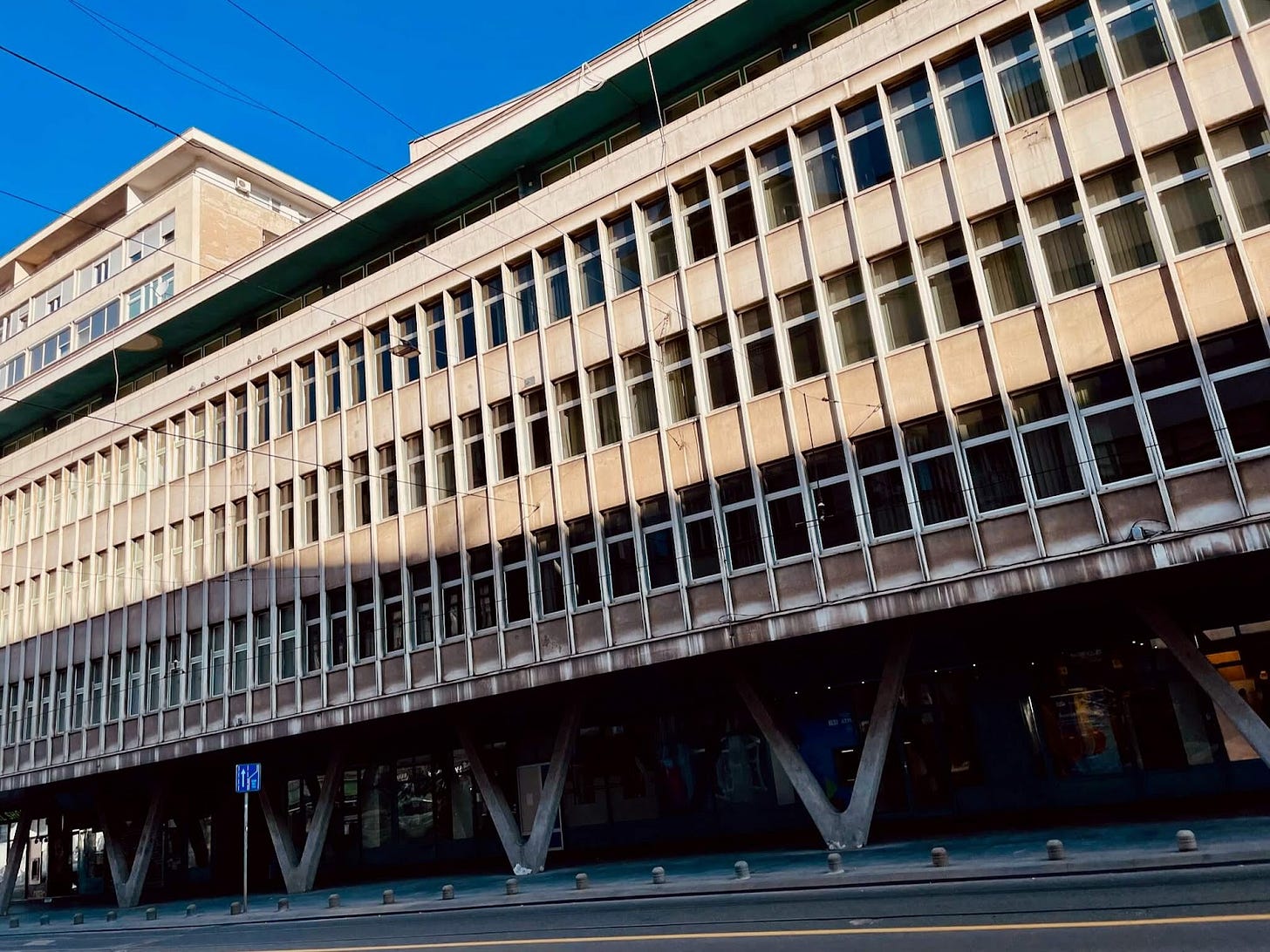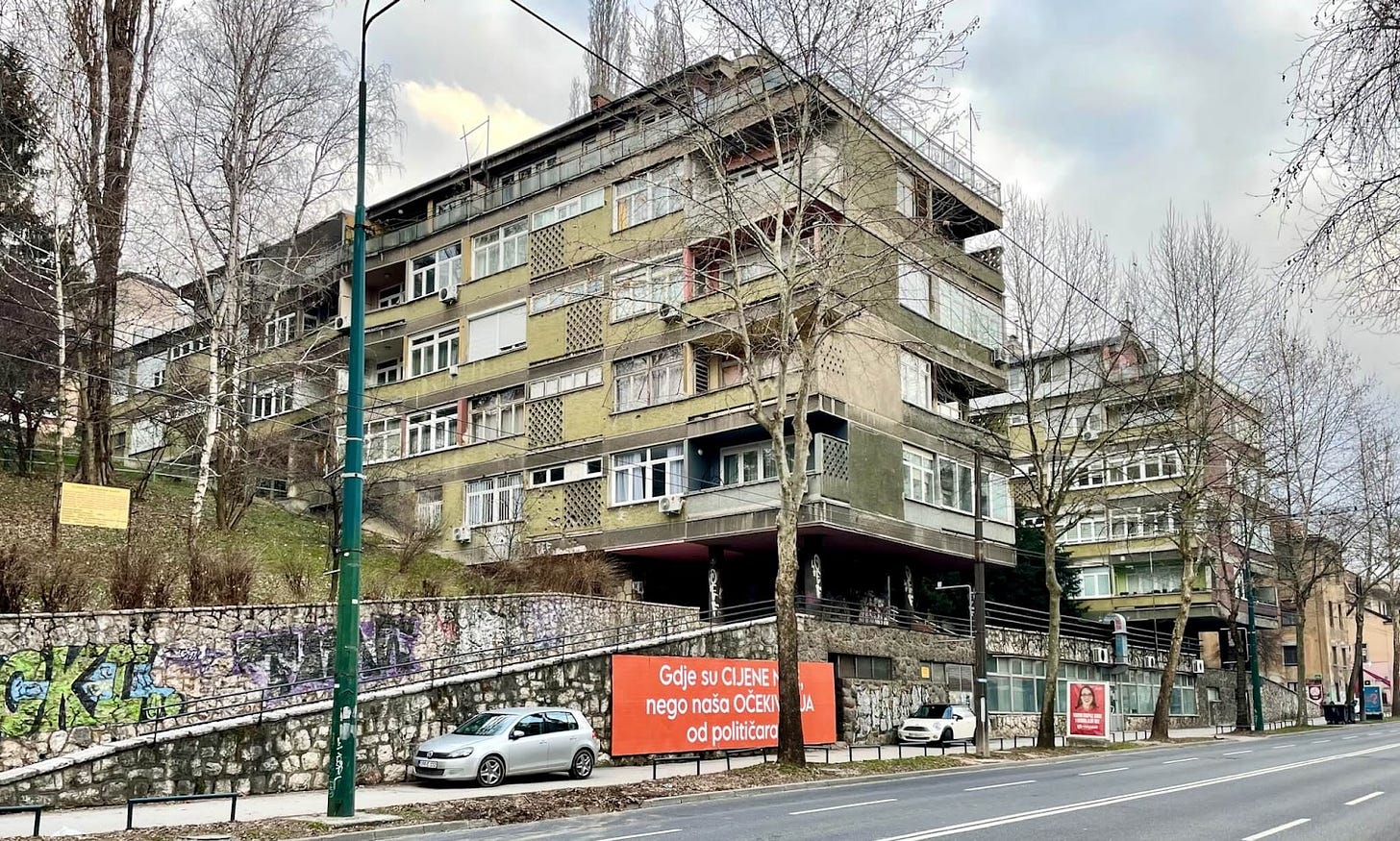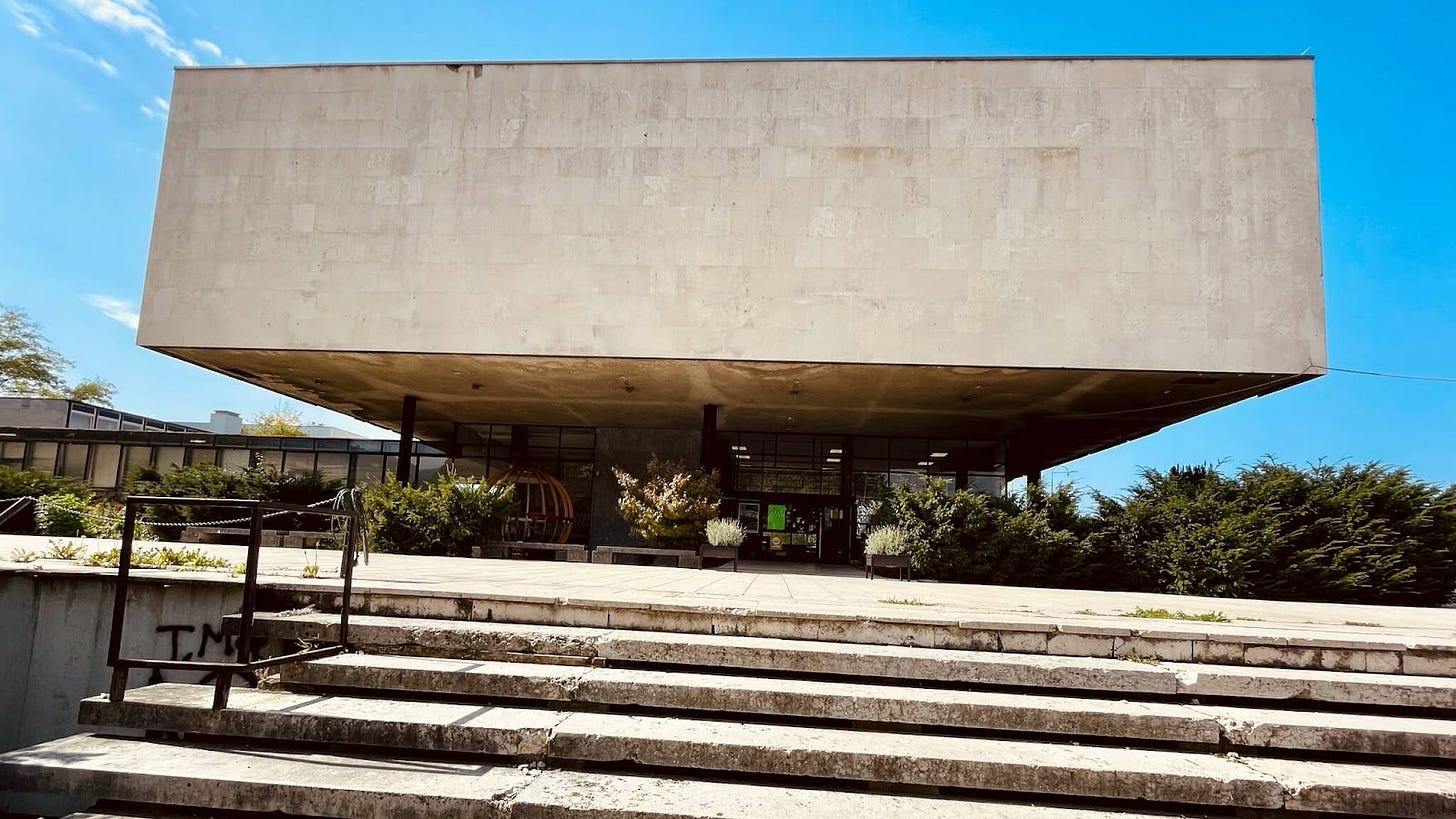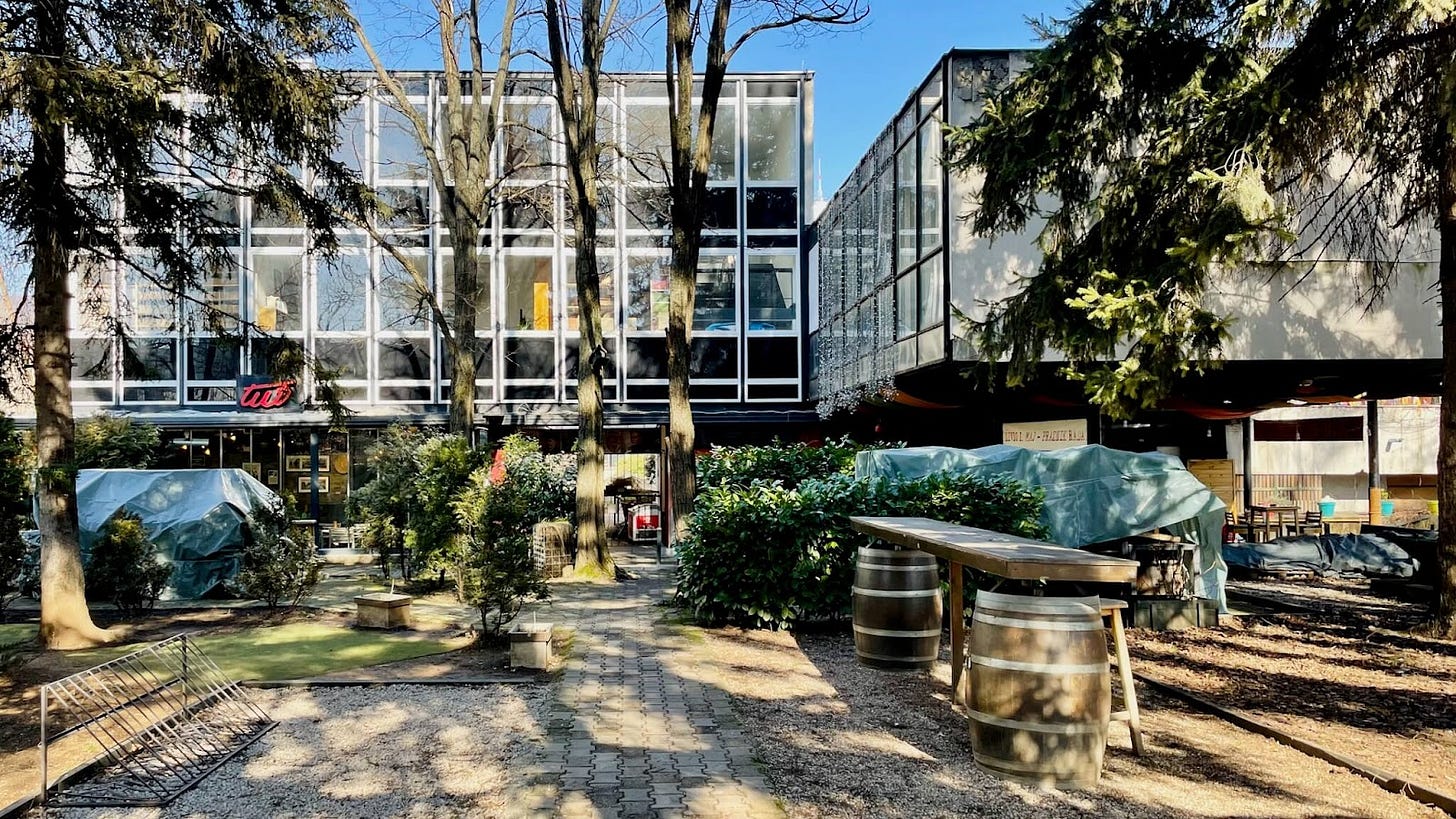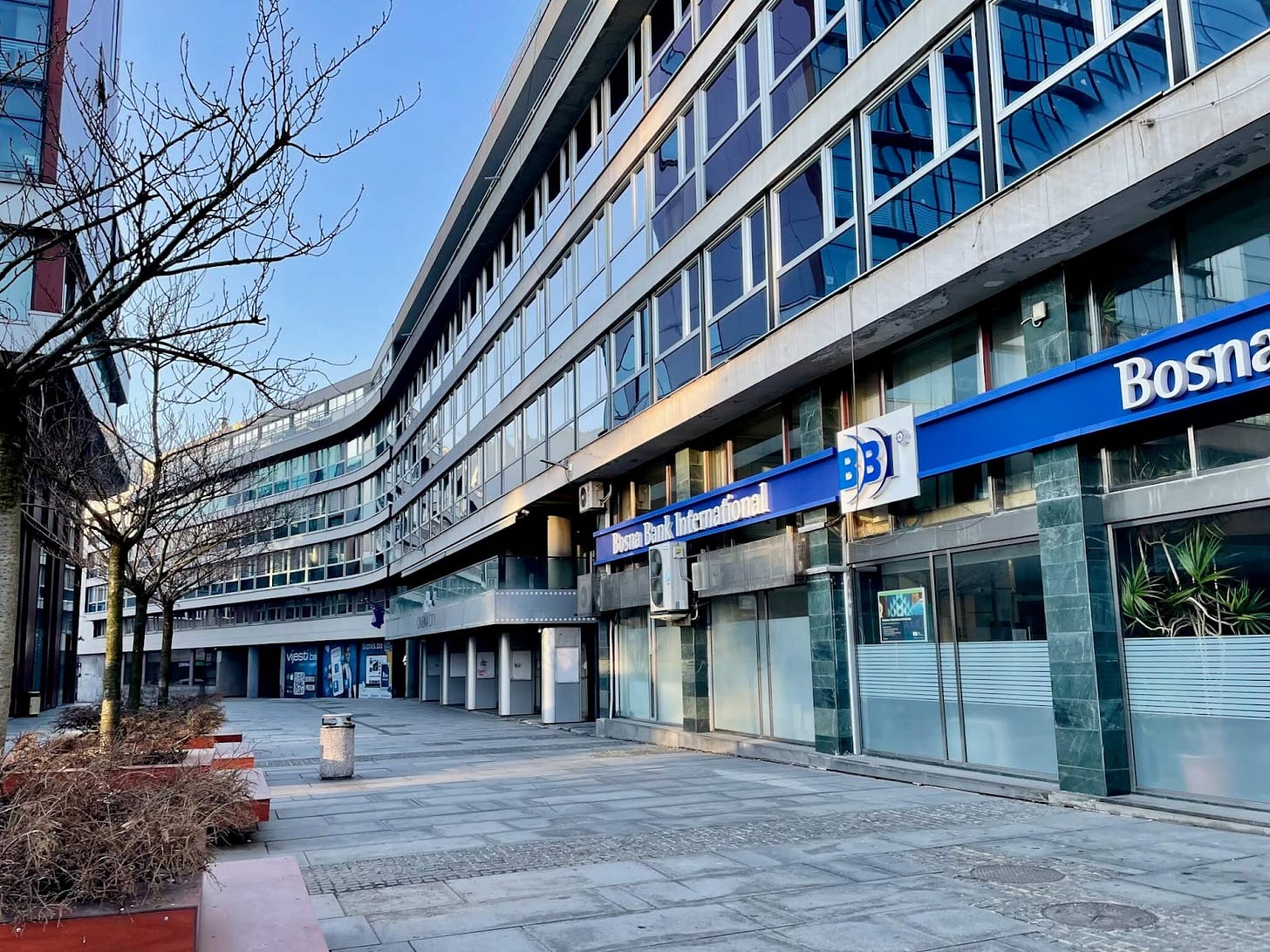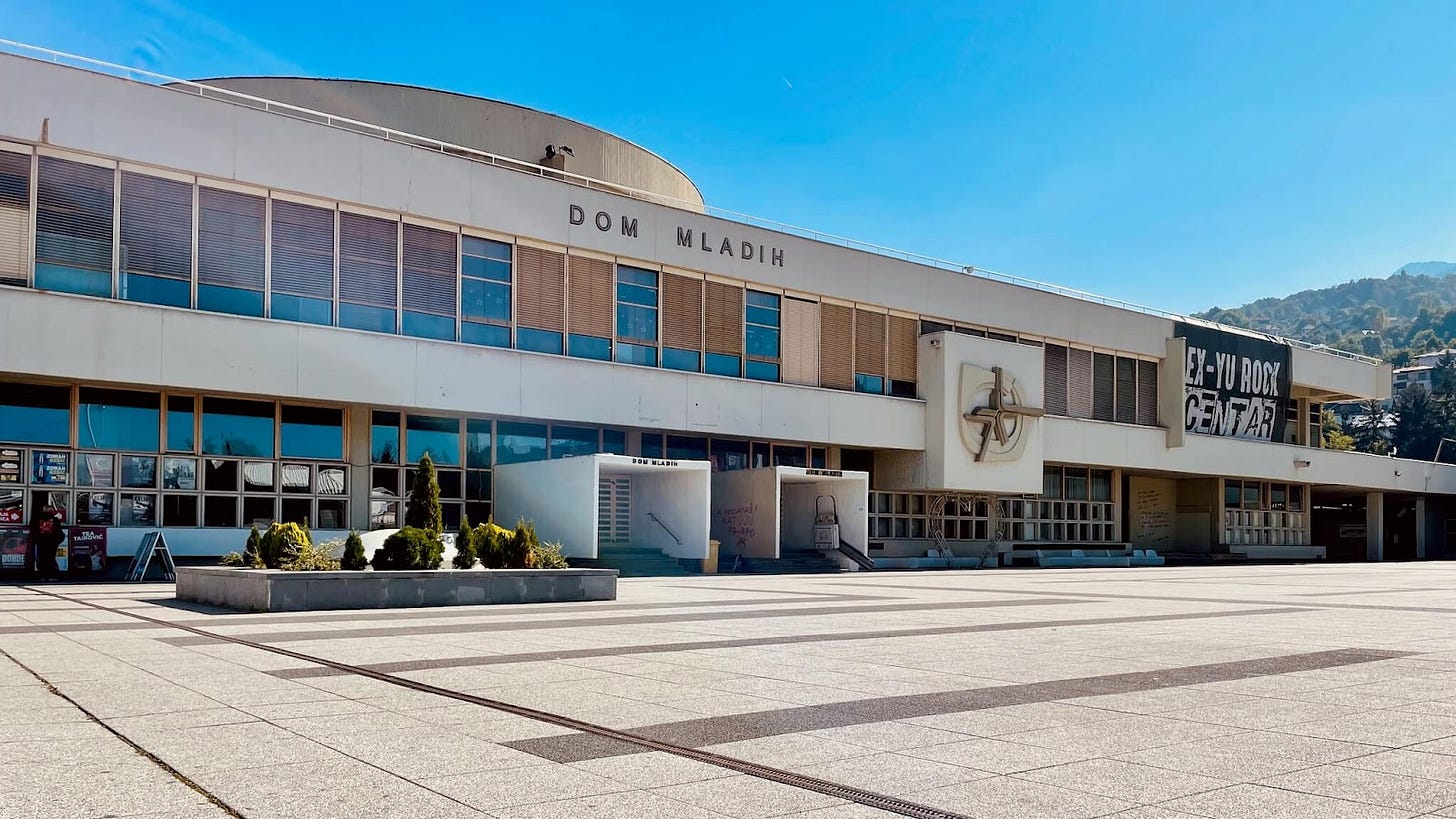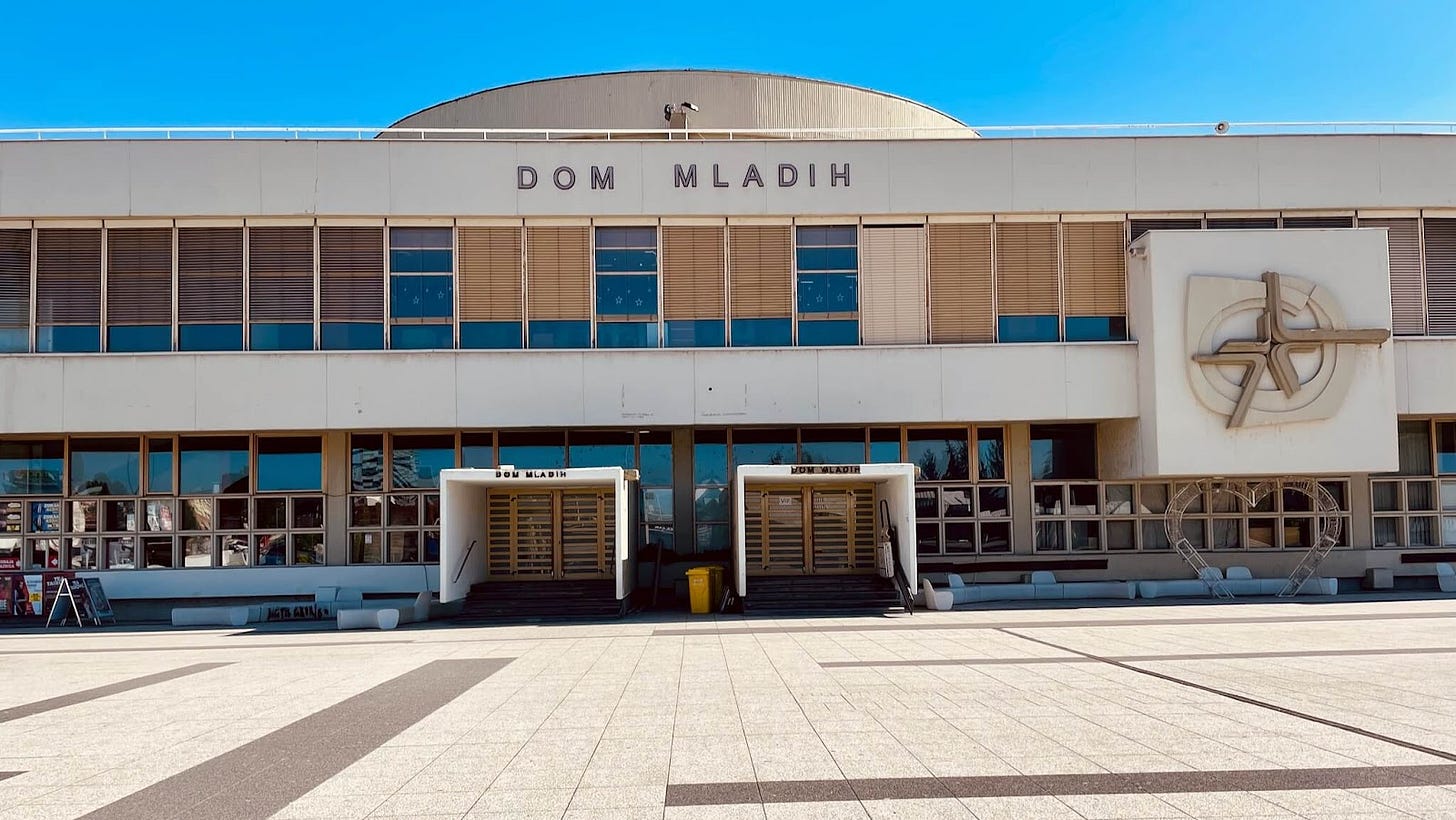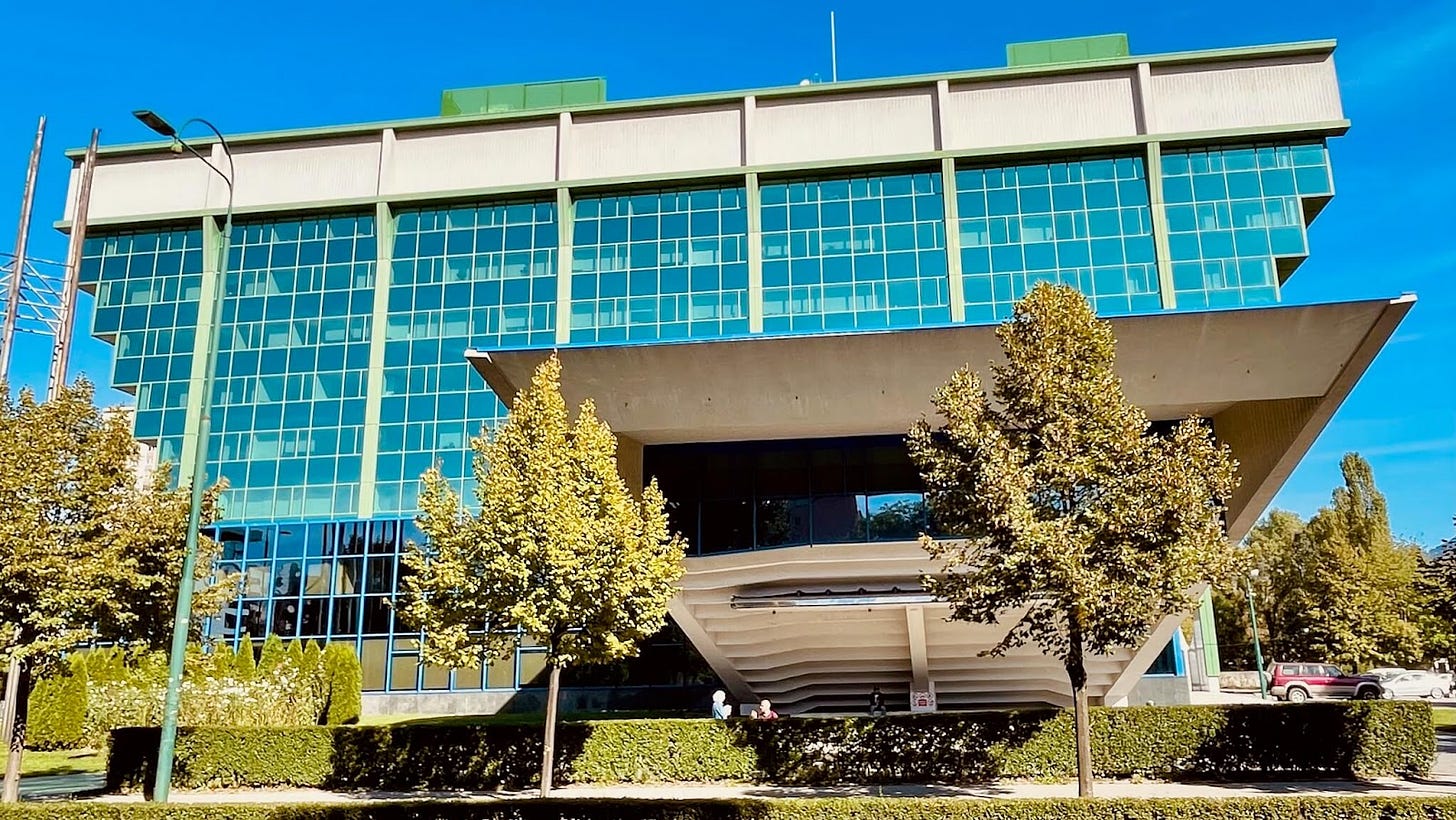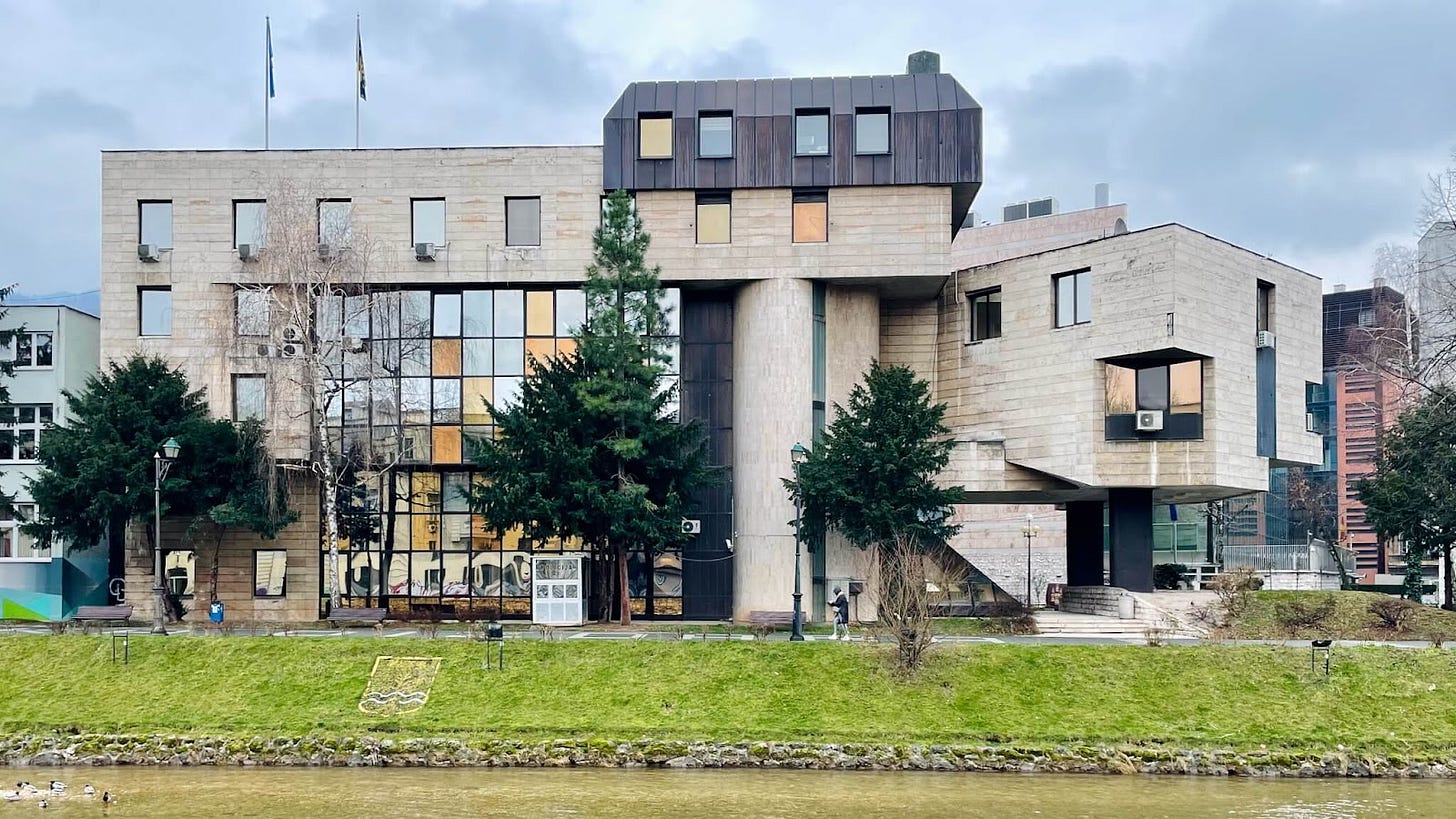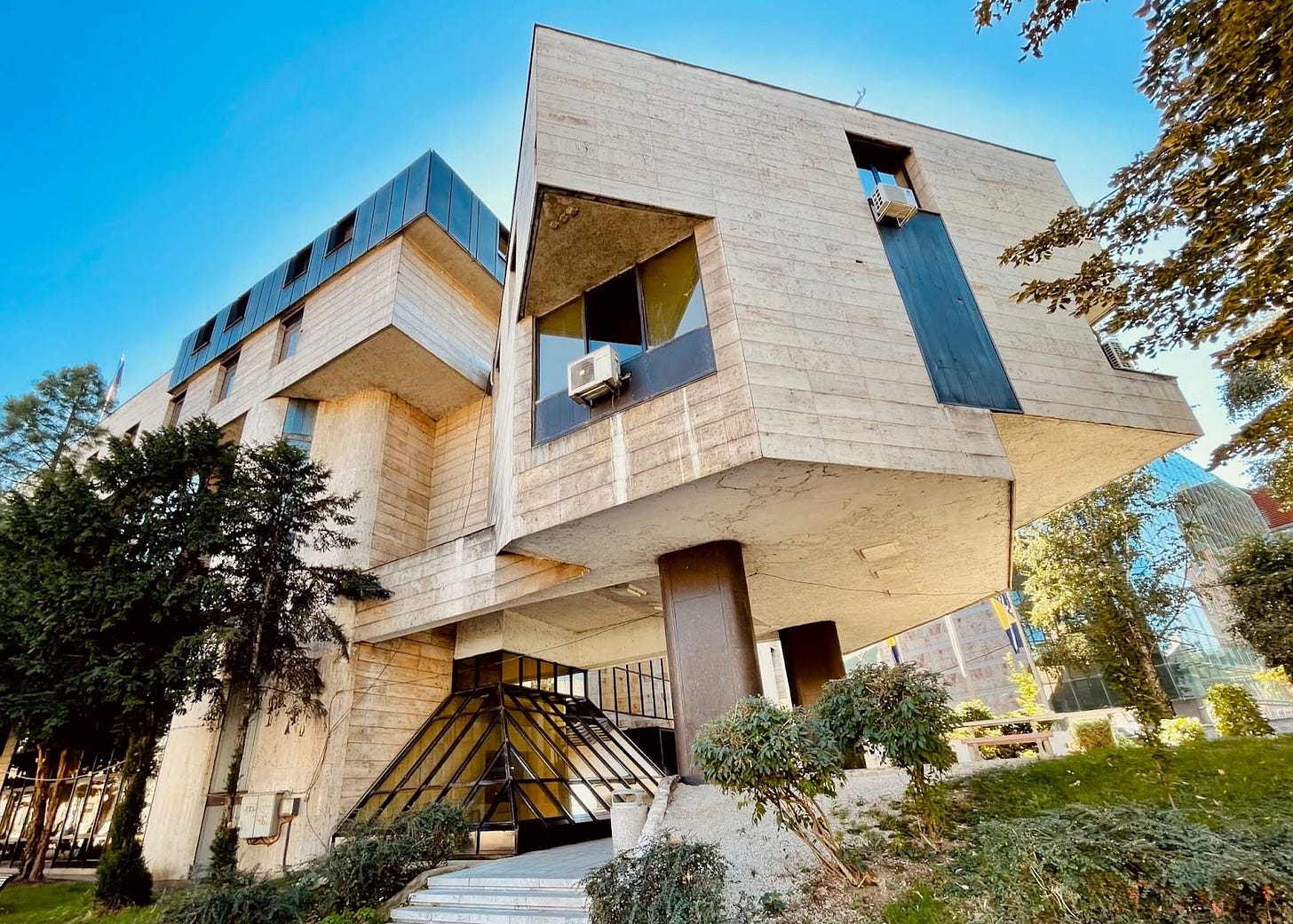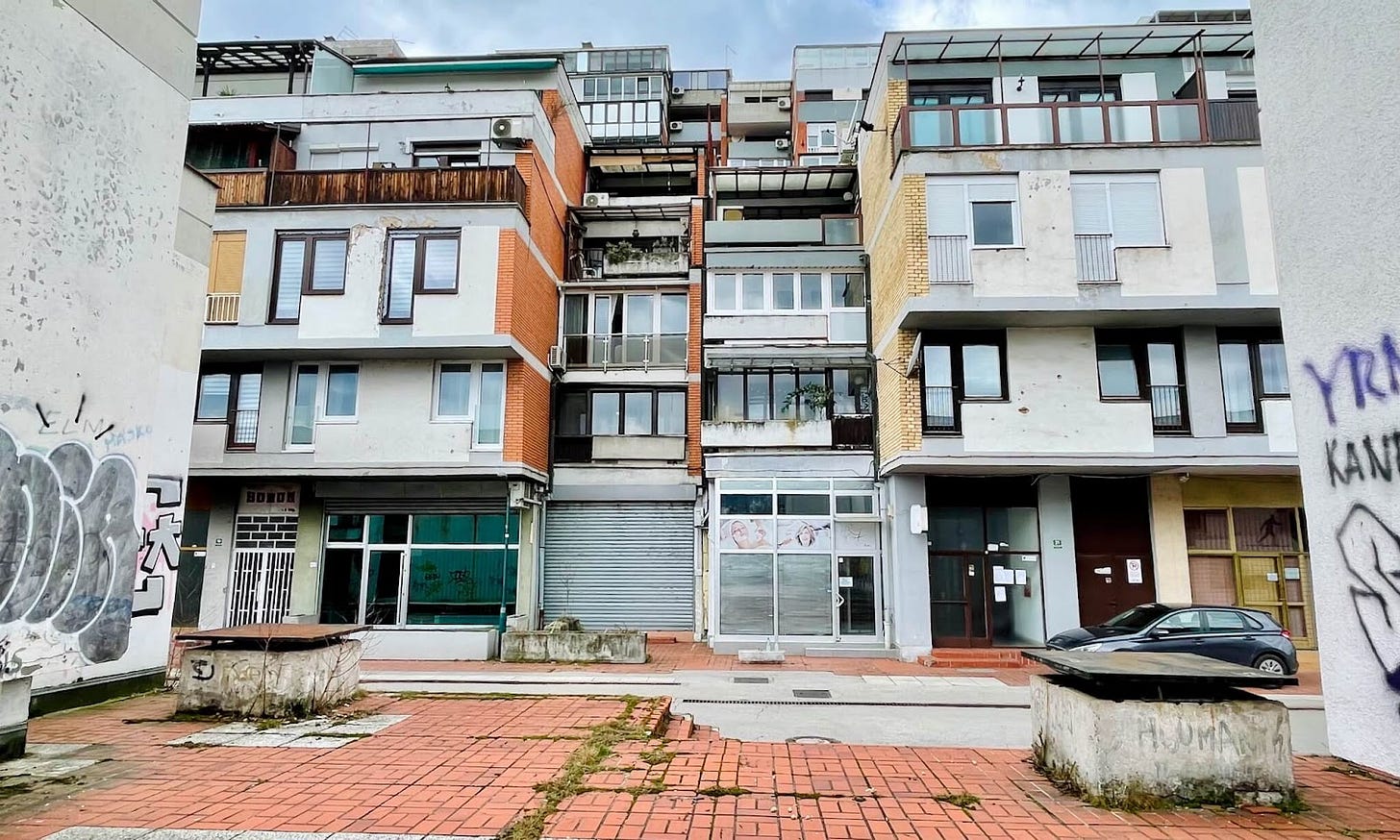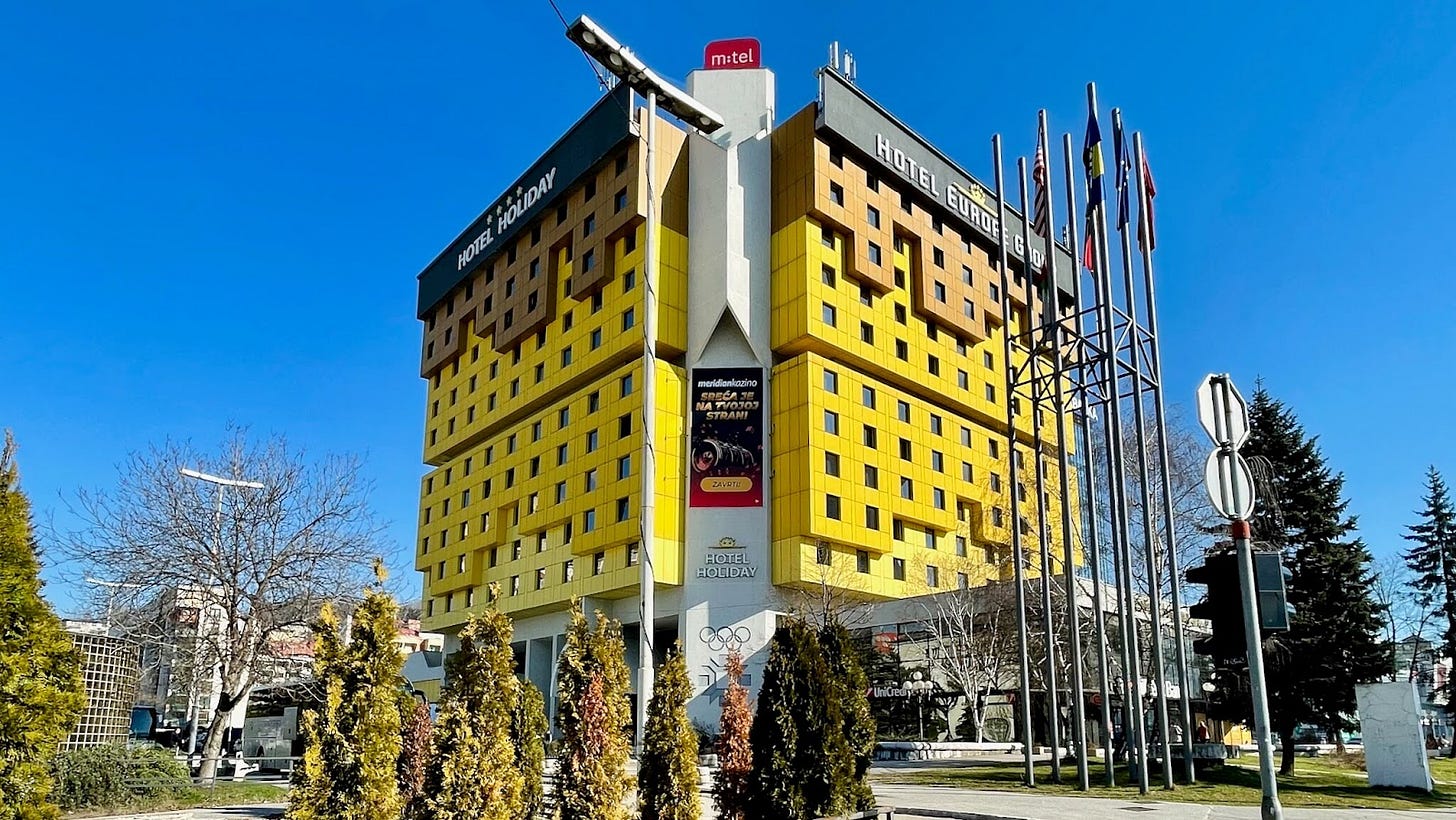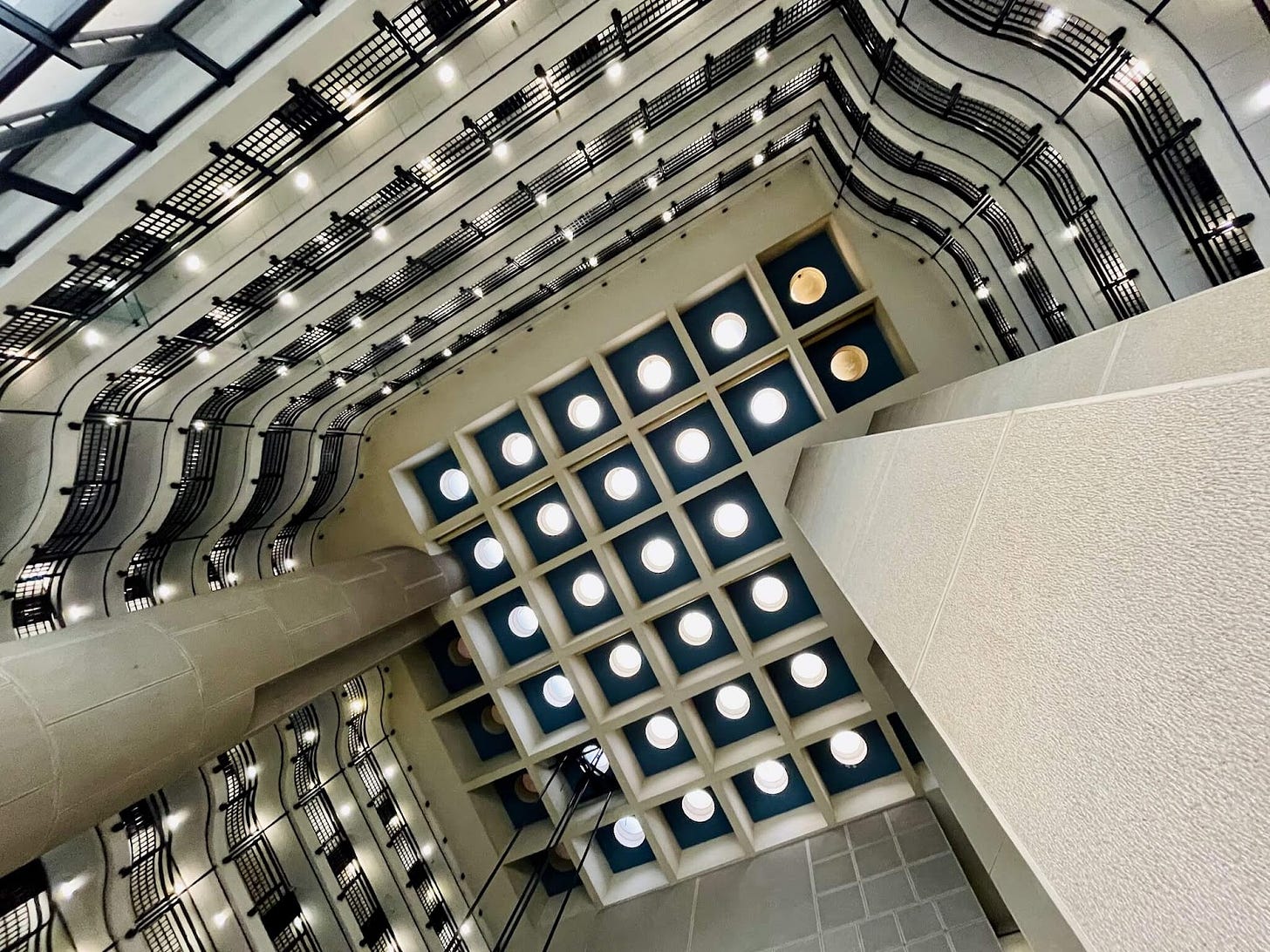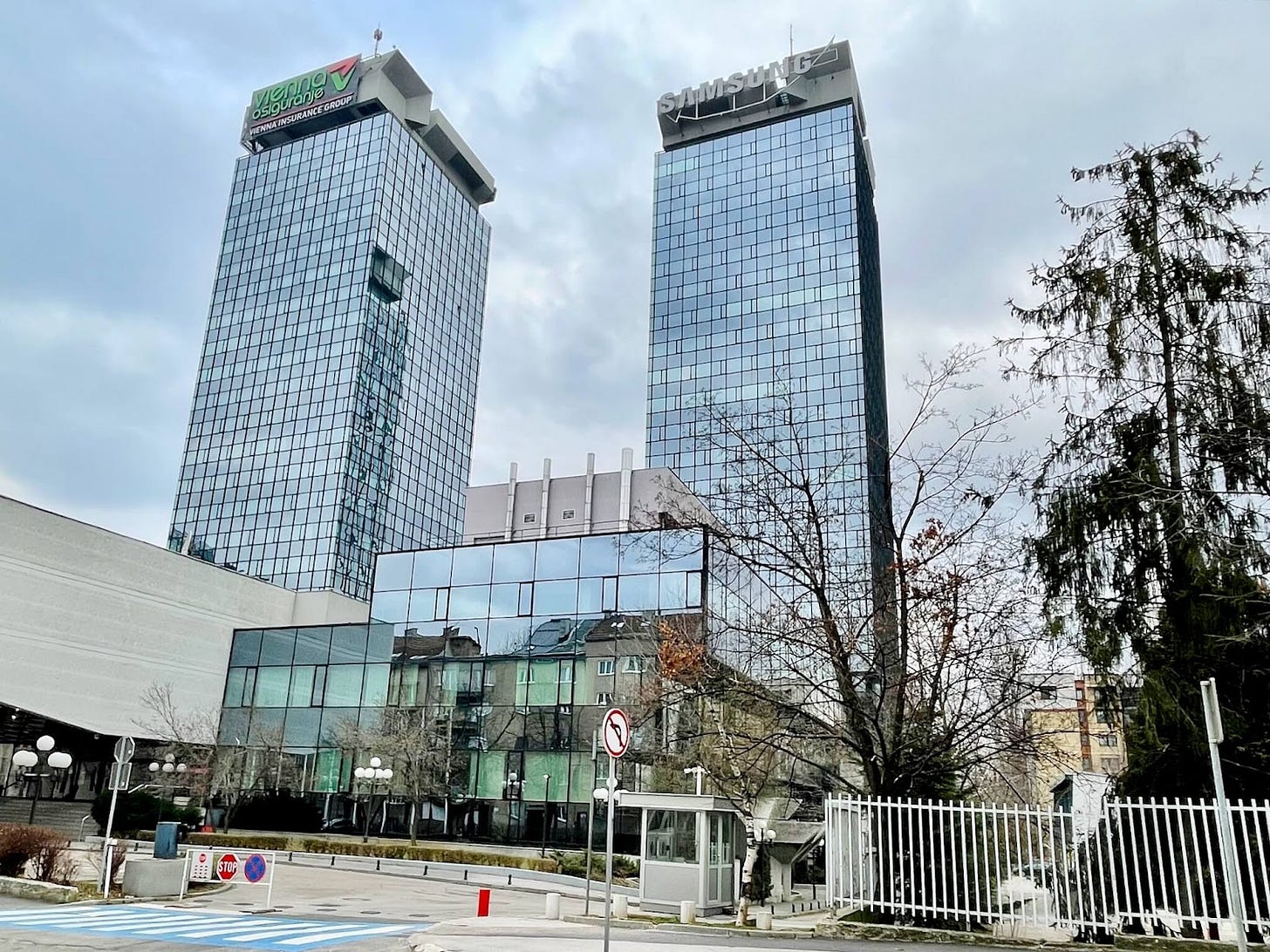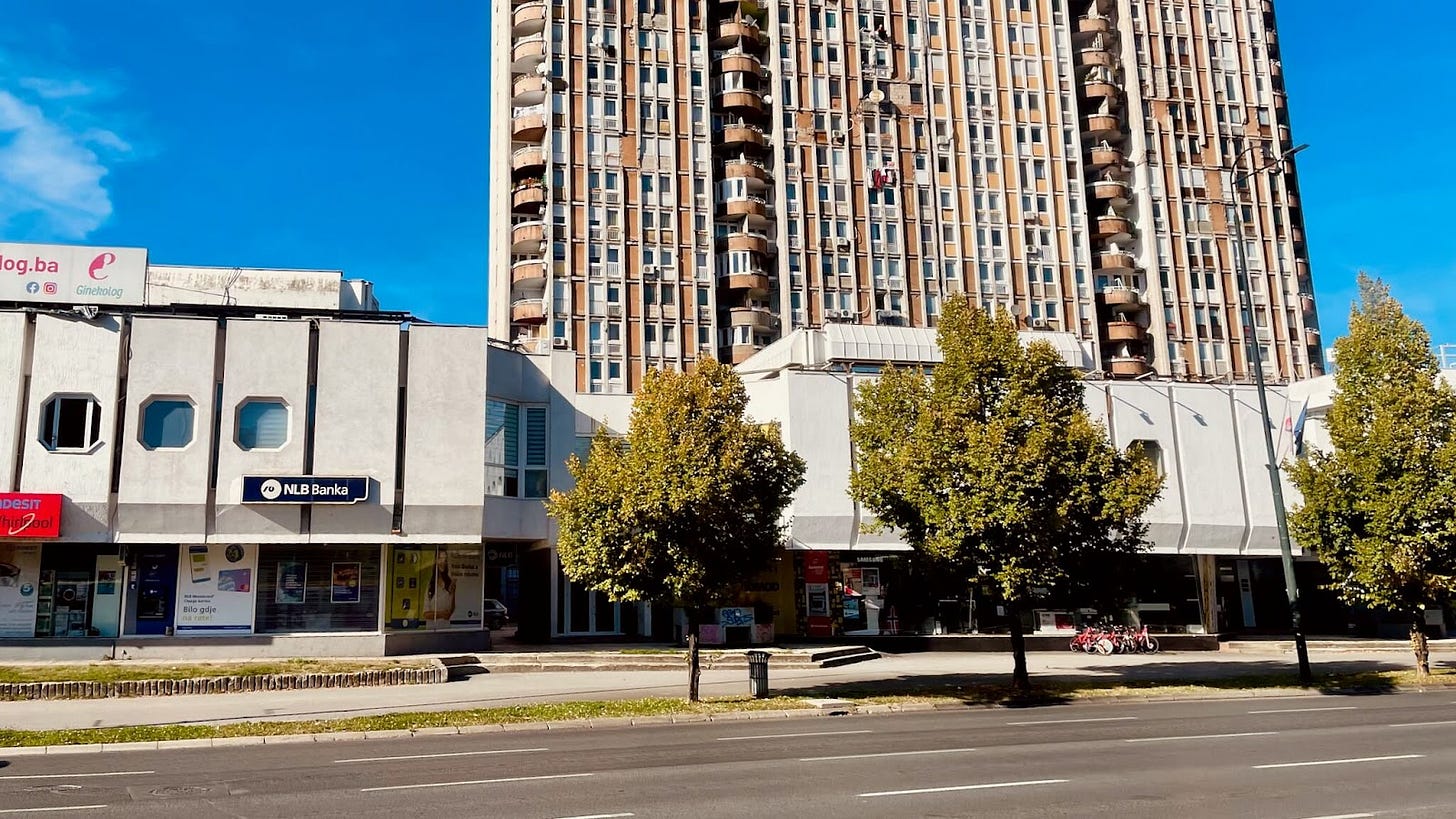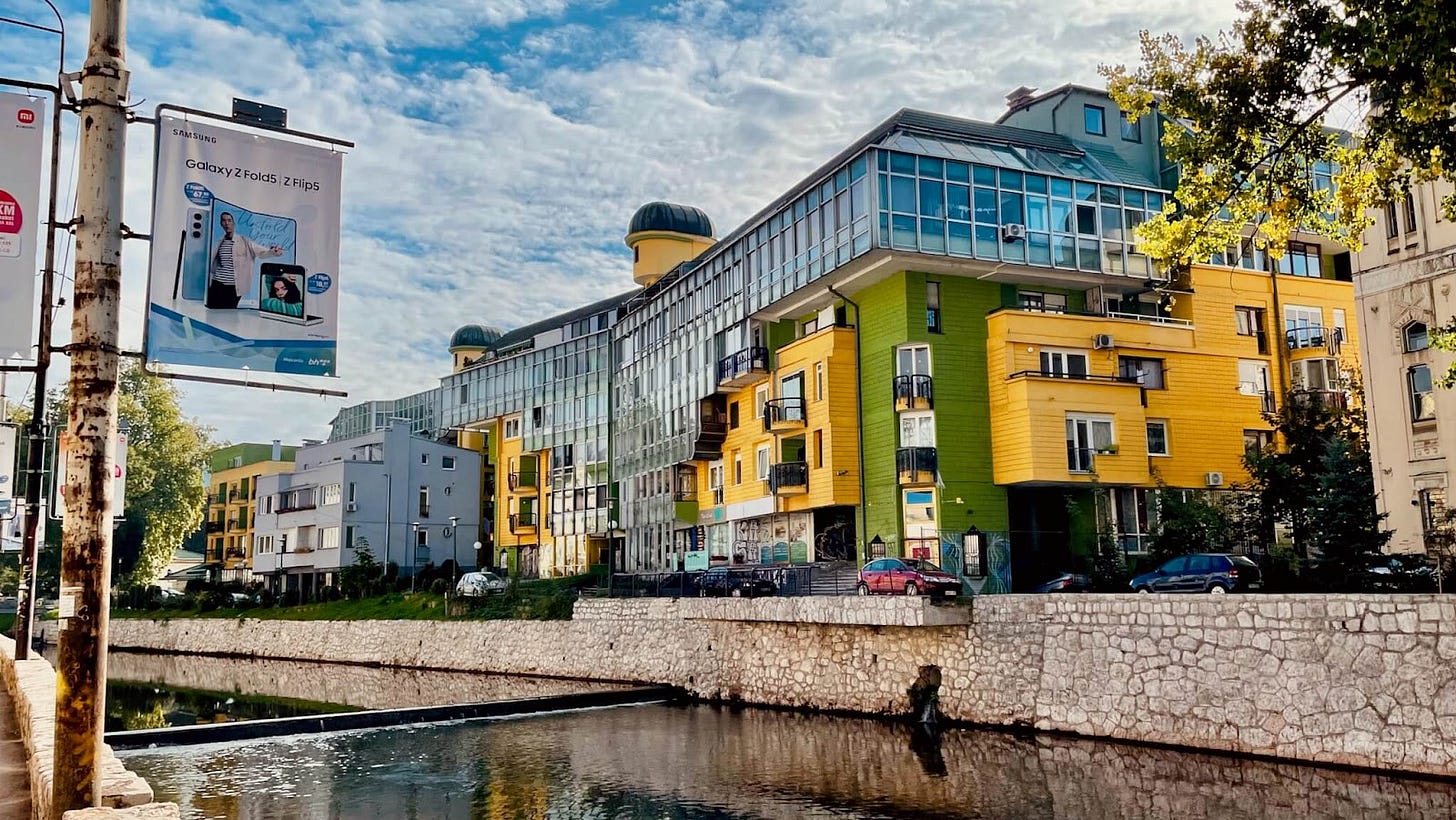Yugoslav Modernism in Sarajevo
Guide to the most significant modernist buildings of the Yugoslav period in Sarajevo, Bosnia and Herzegovina.
The majority of buildings of the socialist modernism era in Sarajevo are located in Novo Sarajevo, and they are primarily residential blocks. However, the most iconic Sarajevo buildings of this period are located somewhere between an old Austro-Hungarian part of the city and a new one.
I included a couple of postmodernist buildings of the late 80s, which also have remarkable elements of modernism.

All places on Google Maps.
1. Pension Fund / Zgrada Penzionog fonda
Hamze Hume 2, Sarajevo, Bosnia and Herzegovina
Years of construction: 1941–1943, designed by Bosnian architects Muhamed and Reuf Kadić.
One of the first modernist buildings in Sarajevo. The building’s appearance contains an influence of early European modernism and constructivism.
2. Residential complex on Džidžikovac (social realism)
Džidžikovac 15, Sarajevo, Bosnia and Herzegovina
Years of construction: 1947–1948, designed by Bosnian architects Muhamed and Reuf Kadić.
The residential complex contains three linear apartment blocks, each consisting of three-story interconnecting buildings cascading along the hill. The complex has a lot in common with «workers’ settlements» of the constructivist period in the soviet union.
In 2008, this Kadić brothers project was declared a protected national monument.
3. Sarajevo Main Railway Station / Żeljeznička Stanica Sarajevo (social realism)
Put života 2, Sarajevo, Bosnia and Herzegovina
Years of construction: 1947–1952, designed by architects: Muhamed Kadić, Emanuel Samanek, Dusan Smiljanic, and Jahiel Finci.
During the design of the railway station, the team of architects was changed due to political drift between Yugoslavia and the USSR. The resulting building is a mix of early modernism and socialist realism.
4. Ministry of Health (social realism)
Maršala Tita 9, Sarajevo, Bosnia and Herzegovina
Ministry of Health
Years of construction: 1950–1953, designed by architect Tihomir Ivanović.
That is an example of transitioning from social realism to «Western» modernism.
5. SIPAD’s Headquarters / Zgrada Šipada
Maršala Tita 15, Sarajevo, Bosnia and Herzegovina
Years of construction: 1953–1956, designed by architect Tihomir Ivanović.
This is a rear modernist building in the old part of the city. «V» columns form a colonnade uphold a porch that protects pedestrians on the sidewalk from rain and sun. The building consists of two merged parts: office space along Marshal Tito Street and a high-raised apartment building.
In the 2010s, the building was sold to BBI bank for only 3.2 million KM = 2000 KM per square meter, which is the price of a square meter of living space on the city’s outskirts.
6. Residential Buildings on Alipašina Street
Alipašina 15, Sarajev, Bosnia and Herzegovina
Year of construction: 1957–1962, designed by architect Juraj Neidhardt.
This is a hillside apartment complex of two buildings.
7. Historical Museum of Bosnia and Herzegovina
Zmaja od Bosne 5, Sarajevo, Bosnia and Herzegovina
Years of construction: 1958–1963, designed by Croatian architects: Boris Magaš, Edo Šmidihen, and Radovan Horvat.
There is a good café Tito on the backside of the museum, inside a small pine grove and with a view of the glass facade of the museum’s library or documents archive.
8. Chamber of Economy of the Federation of Bosnia and Herzegovina / Cinema «Dubrovnik»
Maršala Tita 26, Sarajevo, Bosnia and Herzegovina
Year of construction: 1962, designed by architect Milivoj Peterčić.
The building has a classy look for modernist offices of that period, with ribbon glazing on the facade. Unfortunately, a newly built trade center in front of it hides the full view of the building.
9. UPI Bank / Energoinvest
Branilaca Sarajeva 20, Sarajevo, Bosnia and Herzegovina
Year of construction: 1962, designed by Bosnian architect Živorad Janković.
It is another modernist office building, but its curved facade resembles the Chamber of Economy of the FBH, and its high-rise part is similar to SIPAD’s headquarters.
10. Skenderija
Terezija, Sarajevo, Bosnia & Herzegovina
Years of construction: 1966–1969, designed by Bosnian architect Živorad Janković.
Skenderija is a multipurpose cultural and sports center consisting of several venues.
It was opened on 29 November 1969 to host a premiere of the Yugoslavian epic partisan film «Battle of Neretva». It was modernized to host the 1984 Winter Olympics as a press center and a hockey venue.
11. Dom Mladih
Terezija, Sarajevo, Bosnia and Herzegovina
Years of construction: 1966–1969, designed by Bosnian architect Živorad Janković.
Dom Mladih is a part of the Skenderija center and consists of a dance hall and an amphitheater. It was an essential venue for the Yugoslavian pop and rock scene.
In the days of the siege of Sarajevo, the main building of Skenderija survived without significant damage, but the House of Youth (Dom Mladih) was burned out.
12. BH Pošta
Zmaja od Bosne 88, Sarajevo, Bosnia and Herzegovina
Year of construction: 1976, designed by Bosnian architect Ahmet Kapidžić.
13. Elektroprivreda
Vilsonovo šetalište 15, Sarajevo, Bosnia and Herzegovina
Year of construction: 1978, designed by Bosnian architect Ivan Štraus.
The building was significantly damaged during the siege of Sarajevo, so it had to be completely restored. The contemporary facade lost some of the previous modernist elements.
14. Parlament Federacije Bosne i Hercegovine (postmodernism)
Hamdije Kreševljakovića 3, Sarajevo 71000, Bosnia and Herzegovina
Year of construction: 1980, designed by Serbian architect Vladimir Dobrović.
Despite the year of construction in the era of modernism, the complexity and shapes of the building reveal its belonging to postmodern architecture.
15. RTV Dom (brutalism)
Bulevar Meše Selimovića 12, Sarajevo, Bosnia and Herzegovina
Years of construction: 1973–1983, designed by architects: Milan Kušan and Branko Bulić.
It is the most recognizable brutalist building in Sarajevo.
16. Ciglane, «Naselje Đuro Đaković» neighborhood
Ciglane, Sarajevo, Bosnia and Herzegovina
Years of construction: 1976–1989, designed by Croatian architect Radovan Delalle.
It is a residential estate on a hillside. Thus, most apartment blocks are split into three tiers and built in a terraced style.
Сafes on the lower tier serve as a gathering place for FK Sarajevo fans before football matches, which take place at the stadium nearby.
17. Holiday Inn Hotel (postmodernism)
Zmaja od Bosne 4, Sarajevo, Bosnia and Herzegovina
Years of construction: 1982–1983, designed by Bosnian architect Ivan Štraus.
The hotel was opened a year before the 1984 Winter Olympics and was criticized for its bright facade (what makes a building postmodern). During the war in the 1990s, the hotel became a headquarters for foreign journalists, and from time to time, it was the only place with food, water, and electricity.
After several years of operating after the war, the hotel went bankrupt and lost its «Holiday Inn» brand license. It was reopened in 2016 under the Holiday Hotel name.
18. UNITIC Towers
Fra Anđela Zvizdovića 1, Sarajevo, Bosnia and Herzegovina
Year of construction: 1986, designed by Bosnian architect Ivan Štraus.
UNITIC towers (formerly UNIS Holding BiH) are twin skyscrapers (according to different sources from 90 m to 111 m), commonly known as «Momo and Uzeir». Both towers were severely damaged during the Bosnian War and were renovated in 2000.
19. Kubusi na Pofalićima
Zmaja od Bosne 12–16, Sarajevo 71000, Bosnia and Herzegovina
Years of construction: 1980s, designed by architect Srboslav Stojanović.
Cube buildings along the boulevard have a very futuristic «Soviet» look.
20. Papagajka (postmodernism)
Hamdije Kreševljakovića 61, Sarajevo, Bosnia and Herzegovina
Years of construction: 1982–1990, designed by architects: Dragan Bijedić and Mladen Gvozden.
This is an atypical building for the last years of the existence of socialist Yugoslavia and is a perfect example of a «classic» postmodern building.
Articles and papers on the subject:
Influences of modernism in urban development of Sarajevo in the period 1945–1980 (2022, pdf);
Other Modernism: underpinning the case of the history museum of Bosnia and Herzegovina (2020, pdf);
Heritage of Early Modernism in Residential Architecture in Sarajevo (2019, pdf).
Read more:




